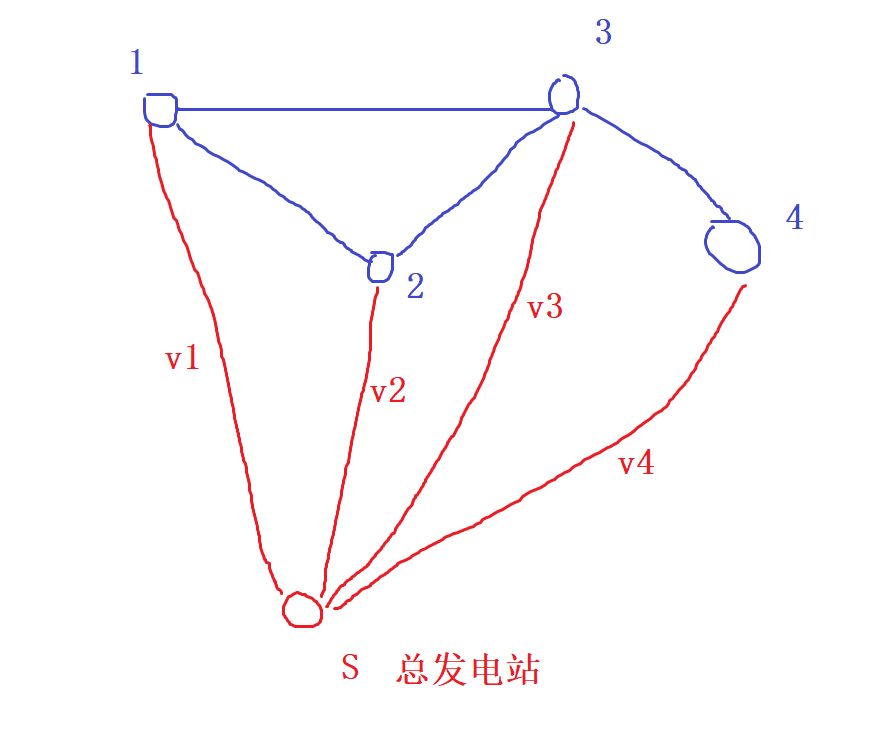You can not select more than 25 topics
Topics must start with a letter or number, can include dashes ('-') and can be up to 35 characters long.
5.1 KiB
5.1 KiB
AcWing 1146. 新的开始
一、题目描述
发展采矿业当然首先得有矿井,小 FF 花了上次探险获得的千分之一的财富请人在岛上挖了 n 口矿井,但他似乎忘记了考虑矿井供电问题。
为了保证电力的供应,小 FF 想到了两种办法:
在矿井 i 上建立一个发电站,费用为 v_i(发电站的输出功率可以供给任意多个矿井)。
将这口矿井 i 与另外的已经有电力供应的矿井 j 之间建立电网,费用为 p_{i,j}。
小 FF 希望你帮他想出一个保证所有矿井电力供应的 最小花费方案。
输入格式
第一行包含一个整数 n,表示矿井总数。
接下来 n 行,每行一个整数,第 i 个数 v_i 表示在第 i 口矿井上建立发电站的费用。
接下来为一个 n×n 的矩阵 P,其中 p_{i,j} 表示在第 i 口矿井和第 j 口矿井之间建立电网的费用。
数据保证 p_{i,j}=p_{j,i},且 p_{i,i}=0。
输出格式 输出一个整数,表示让所有矿井获得充足电能的最小花费。
数据范围
1≤n≤300,0≤v_i,p_i,j≤10^5
输入样例:
4
5
4
4
3
0 2 2 2
2 0 3 3
2 3 0 4
2 3 4 0
输出样例:
9
二、解题思路
为了节点i供应电力,有两种办法:
- 在节点
i建发电站,代价为v_i - 与另外的已经有电力供应的矿井
j之间建立电网,代价为p_{i,j}
上面两种情况,第一个是 点权,第二个是 边权,不太好统一口径,这种问题的 经典作法 是: 利用超级源点将点权转化为超级源点到当前点的边权!
-
在节点
i建发电站的费用是v_i,建立虚拟结点S,相当于i号点到S号点的费用是v_i -
求
n个矿井电力供应的最小花费,等价于求n + 1个点的最小生成树
三、Kruskal算法
#include <bits/stdc++.h>
using namespace std;
const int N = 310;
int n; // n条顶点
int res; // 最小生成树的权值和
// Kruskal用到的结构体
const int M = 2 * N * N; // 无向图*2,稠密图N*N
struct Edge {
int a, b, c;
const bool operator<(const Edge &t) const {
return c < t.c;
}
} edge[M];
int el; // 边数
// 并查集
int p[N];
int find(int x) {
if (p[x] != x) p[x] = find(p[x]);
return p[x];
}
// Kruskal算法
int kruskal() {
// 按边的权重排序
sort(edge, edge + el);
// 初始化并查集,注意并查集的初始是从0开始的,因为0号是超级源点
for (int i = 0; i <= n; i++) p[i] = i;
// 枚举每条边
for (int i = 0; i < el; i++) {
int a = edge[i].a, b = edge[i].b, c = edge[i].c;
a = find(a), b = find(b);
if (a != b)
p[a] = b, res += c;
}
return res;
}
int main() {
cin >> n;
// 建立超级源点(0 <-> 1~n )
int c;
for (int i = 1; i <= n; i++) {
cin >> c; // 点权转边权
edge[el++] = {0, i, c};
edge[el++] = {i, 0, c};
}
// 本题是按矩阵读入的,不是按a,b,c方式读入的
for (int i = 1; i <= n; i++)
for (int j = 1; j <= n; j++) {
cin >> c;
edge[el++] = {i, j, c};
edge[el++] = {j, i, c};
}
// 利用Kruskal计算最小生成树
cout << kruskal() << endl;
return 0;
}
四、Prim算法
#include <bits/stdc++.h>
using namespace std;
const int N = 310;
int n;
int g[N][N];
int dis[N];
bool st[N];
int res; // 最小生成树里面边的长度之和
void prim() {
memset(dis, 0x3f, sizeof dis); // 初始化所有距离为INF
dis[0] = 0; // 超级源点是在生成树中的
for (int i = 0; i <= n; i++) { // 注意:这里因为引入了超级源点,所以点的个数是n+1
int t = -1;
for (int j = 0; j <= n; j++)
if (!st[j] && (t == -1 || dis[t] > dis[j])) t = j;
if (i) res += dis[t];
// 有超级源点的题,是必然存在最小生成树的
// 注意这里也是需要从0~n共n+1个
for (int j = 0; j <= n; j++)
if (!st[j] && dis[j] > g[t][j])
dis[j] = g[t][j];
st[t] = true;
}
}
int main() {
cin >> n;
// 建立超级源点(0 <-> 1~n ),点权转化为超级源点到此节点的边权
for (int i = 1; i <= n; i++) {
int c;
cin >> c;
g[i][0] = g[0][i] = c;
}
// 本题是按矩阵读入的,不是按a,b,c方式读入的
for (int i = 1; i <= n; i++)
for (int j = 1; j <= n; j++)
cin >> g[i][j];
// 利用prim计算最小生成树
prim();
cout << res << endl;
return 0;
}
